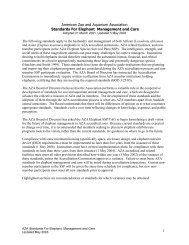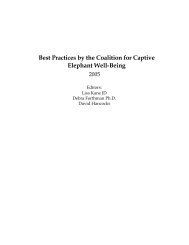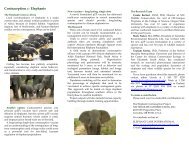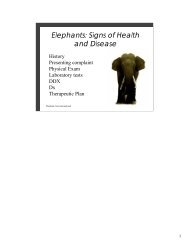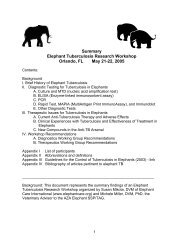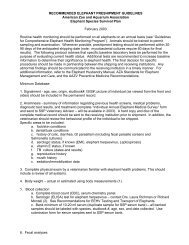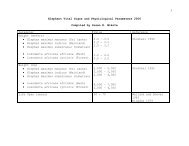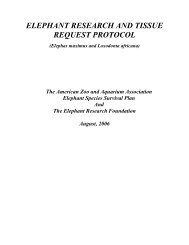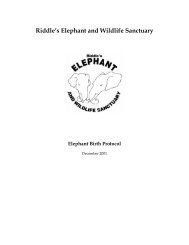Nepal Elephant TB Control and Mgt Action Plan.pdf - Elephant Care ...
Nepal Elephant TB Control and Mgt Action Plan.pdf - Elephant Care ...
Nepal Elephant TB Control and Mgt Action Plan.pdf - Elephant Care ...
- No tags were found...
You also want an ePaper? Increase the reach of your titles
YUMPU automatically turns print PDFs into web optimized ePapers that Google loves.
nucleic acid (DNA or RNA) are replicated, allowing for detecon of target sequences.Prevalence: The total number of cases of a specific disease in a given populaon at a given me.Quaran ne: Enforced segregaon to prevent the spread of an infecous disease.Reac ve: Presence of response; in the context of serological tesng for <strong>TB</strong> in elephants, a reacve resultindicates that an angen-anbody reacon has occurred.Segrega on: Separaon from others. In context of this protocol, segregaon at the home faciliesmeans to keep an elephant apart from other elephants by a minimum distance of 15 meters <strong>and</strong> tomaintain an empty stall on either side of the segregated elephant. Segregaon can also be at a locaonremote from the home facility such as the segregaon facility in Kasara.Sensi vity: A measure of the ability of a test to idenfy infected animal (i.e. the percentage of true posi-ve results). Sensivity is the frequency of a posive or abnormal test result (e.g. a test that is outside ofthe reference interval) when a disease is present (i.e. the percentage of true posive results). Sensivity= [TP ÷ (TP + FN)] X 100 where TP = true posive; FN = false-negave).Shedding: Acve excreon of live <strong>TB</strong> organisms, usually in respiratory secreons. Indicates that anelephant is infecous to other animals or humans. Shedding is determined by culture, PCR, or othertechnologies that detect <strong>TB</strong> organisms.Specificity: A measure of the ability of a test to idenfy non-infected animals (i.e. the percentage of truenegavetest results). Specificity is the frequency of a negave or “normal” test result when a disease isabsent (i.e. the percentage of true-negave (TN) test results. Specificity = [TN ÷ (TN + FP)] X 100.Triple sample method: A method of sample collecon whereby 3 samples are obtained on separatedays.Trunk wash <strong>and</strong> modified trunk wash: Procedures used in elephants to obtain a sputum sample forculture or PCR.<strong>TB</strong>-infected: An elephant that is reacve on the <strong>Elephant</strong> <strong>TB</strong> Stat-Pak ® test <strong>and</strong> the DPP Vet ® <strong>TB</strong> test orfrom which <strong>TB</strong> complex organisms have been idenfied by culture or molecular techniques.<strong>TB</strong> suspect: An elephant that is reacve on the <strong>Elephant</strong> <strong>TB</strong> Stat-Pak ® test.Tuberculin skin test: A screening test for <strong>TB</strong> used in humans <strong>and</strong> some animals. The test cannot accuratelydiagnose <strong>TB</strong> in elephants <strong>and</strong> it is not recommended.




